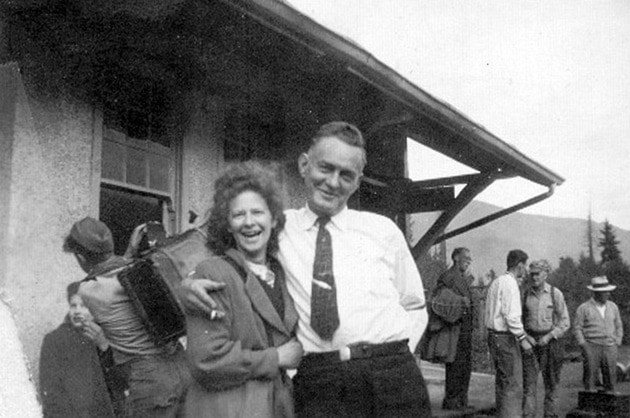Eleanor Deckert
The Nov. 24, 1915, Kamloops Standard announced the first through transcontinental train along the Canadian Northern Railway, but that was not the beginning or the ending of the story.
The January 29, 1909 issue of the semi-weekly Inland Sentinel (from the Kamloops Archives) sounded the excitement surrounding western development of the times.
“North of Kamloops is such good country ... Construction of the Canadian Northern Railway along this route will open up a large and rich territory and bring it into direct and quick connection with Vancouver.”
The significant feature of this route was the low grade – “not to exceed 1/2 of 1% between Hope and Kamloops ... low gradients are also secured between Kamloops and Yellowhead Pass.”
And with that excitement came competition, as the June 22, 1909 issue points out.
The Grand Trunk Pacific and Canada Northern were rivals surveying nearly identical routes.
“Both companies have engineering parties in the field locating lines.”
Construction
Confidence was high in the April 1, 1912 issue, which states that construction was scheduled to begin June 1, 1912, between New Westminster and Hope, with a major headquarters site at Kamloops to oversee construction towards the northwest.
Ida Dekelver’s collection housed in the Yellowhead Museum supplies photos and facts.
“The stretch from Kamloops Junction to Irvine at Mad River was finished in 1913; from Irvine to Wire Cache in 1914; Wire Cache to Pyramid beyond Blue River and south of the Albreda in 1915. The east and west sections of construction met at Lempriere, three miles south of the Albreda River.”
The line was finished in January 1915. However, a hastily-built tunnel near Cisco in the Fraser Canyon collapsed. The ceremony for the Last Spike was held in May, 1915.
The book North River by Muriel Poulton Dunford shares personal stories.
It is hard to realize that before the steam locomotives chugged along the miles, muscle power was the only form of transportation north of the Pea Vine steam paddle-wheeler dock (west of Vavenby). People, horses, mules and oxen were walking, pulling or packing loads.
At the eastern end of the line, in the winter of 1911, Edgar Fortier and Doc Harrison ran pack trains from Edmonton to supply the workers along the CNR line.
One story told is how Louis Knutson, who was trapping near Lempriere, came across a survey crew stranded by an early snowstorm. He went to get help. Donald Gordon had a roadhouse near Lempriere. He came to rescue the stranded men with a home-made toboggan and snowshoes. They got to Blue River and eagerly renewed their supplies from G.S. Stewart’s trading post.
Everything changed with the dawn of the steam-powered trains. Freight from Canada’s mines and forests, farms and factories could be exported.
Incoming goods from ports, tools and technology, expand commerce. Even families of settlers could bring their cargo. Passengers from all over the world were seated in comfort, enjoying the scenery which was so recently hazards, obstacles and barriers.
World War I
Expansion was suddenly threatened by World War I. Funding from English investors was no longer available. There were fewer European immigrants, which meant fewer workers. The company was in debt. Wages, materials and other costs increased.
In 1919, Ottawa took over, passing an act creating the Canadian National Railway. It was not logical for taxpayers to finance two parallel lines from Edmonton to the Alberta border, so 300 miles of rails were torn out, sent to France and used for moving big guns and war machinery
By 1923, CNR included tracks that had belonged to 221 different railroads!
Upper North Thompson Reflections, a history book for Clearwater and area, features 10 pages with 31 photographs devoted to descriptions of development of the CNR along the valley corridor: construction projects, locomotives, stations, and glimpses into daily life and how the early rail service impacted the life of the residents of the North Thompson River valley.
Improvements described in the article by Alfred Graffunder explains, “The railway is always upgrading, bigger and better steel, more ballast and roadbeds, concrete ties, continuous rails ... signal system....”
Hazel Small wrote about a track-side ceremony held April 17, 1966, that marked B.C.’s centennial year. After special arrangements had been made through Montreal, the passenger train stopped for 21 minutes in Clearwater so the significance of the CNR to local history and development could be recognized with gifts for the train crew, including the presentation of four blueberry pies.
Valemount Museum houses artifacts of interest, preserving history through tools, technology, descriptions and a model train.
Then there are the details that are only available through an interview, asking questions of a person who is familiar with the railroad as it operates in more recent time.
The writer’s husband, Kevin Deckert, recently retired as a track maintenance foreman. He explained that each rail has a manufacturing date stamped on it. Today workers still come across rail from the early days. During his 33 years, he and his crew have changed out rail dated even as early as 1915.
Below: The CNR station at McMurphy once served a small but thriving community. Now just a few people live in the area and there is no station.

